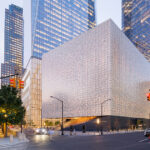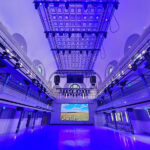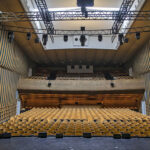Complete refurbishment, acoustic overhaul and state-of-the-art lighting and video installations: it sounds like improvements made for a theatrical company of national significance, not a high school auditorium in Kentwood, Mich. But sometimes star treatment is found in strange places — and East Kentwood High School’s refurbished high school now contains technology and planning that puts it on par with many of the country’s top performance venues. Multifaceted — and Outdated
Originally built in the late 1960s, the Fine Arts Auditorium at East Kentwood High School primarily serves a high school population of more than 2,500, providing a home for the school’s choral concerts, theatrical productions, band concerts and even a “Battle of the Bands.” However, the space has taken on larger significance for the community of Kentwood, which watches a busy slate of national and regional performances, from orchestral music to jazz to touring productions of operas, such as Carmen, and musicals. “We even had a circus in here one time, complete with elephants,” notes Rick Westers, who has taught production at East Kentwood High for more than 20 years in addition to serving as a freelance sound engineer in the Kentwood area.
But time was not kind to the Fine Arts Auditorium, which had become tired, outdated and more than a little worn down. Given its diverse functions and the opportunity for hands-on learning in a bona fide production environment at the high school, taxpayers and the school district approved funding for a complete renovation and refurbishment of the Fine Arts Auditorium, unlike the “bandaid” approach adopted — and unfortunately afforded — by other school districts. In order to reverse the toll of decades of decay, the facility was stripped down to four walls and completely overhauled.
Designed by GMB Architects & Engineers of Holland, Mich., the new facility was designed with acoustics in mind — Michigan- based acoustics and technical systems design firm Acoustics By Design was on board, and lead tech Tim Hamilton, CTS worked with Westers, the architects and a team of specialists to help design the facility’s innovative components, from sound to video to lighting.
Lighting Helps New Complex Shine
After the innovative acoustics were complete, it was time to address the stage magic — lighting. The lighting system was in dire need of expansion; in fact, the old system consisted of only one lighting position and several stage electrics. Light fixtures were old and run-down, while the dimming system was outdated from the perspectives of both performance and control protocol. But the biggest lighting obstacle for the East Kentwood Fine Arts Center was to be found above the stage — the house catwalk was positioned too close to the stage. This presented a lighting quandary: the existing fixtures were located at too steep of an angle to the front of the stage, and it was virtually impossible to light anything on the floor upstage with the current catwalks in place.
Undaunted by the challenges of the existing catwalk system, Acoustics By Design, GMB Architects & Engineers and high school representatives began to brainstorm. Their first decision: abandon the existing catwalks and remove the room’s ceiling in order to address crucial questions of lighting design. The renovated space would call for an entirely new catwalk system that allowed access from both sides of the room. Front and side lighting positions and followspot locations were added in order to expand the lighting possibilities in the space. These architectural additions required close coordination between different components, such as acoustical clouds, fixtures, loudspeakers and the catwalks themselves. The result: perfect positioning with no conflicts between competing elements.
Next came crucial decisions about the dimming system. In this case, all parties decided on a system purchased from Electronic Theatre Controls (ETC). One-hundred and ninety-two circuits were distributed over the catwalks and the stage, and two 96-circuit Sensor dimming racks were specified to control the entire dimming system. The dimmers were networked through ETC’s proprietary Net2 wiring protocol, which distributes control signals through inexpensive Cat5 cables. The space is fully DMX-able, with DMX nodes located on racks, catwalks, electrical fixtures and in the booth and providing DMX capability that integrates and controls the entire system.
Moving light fixtures were added to the mix, in this case, ETC Revolutions. The choice of moving lights was influenced by the choice of control: the ETC Emphasis system integrates moving fixtures with their conventional counterparts and also incorporates house lights for global command of all lighting components. The stage manager’s panel backstage was improved with the help of a rack-mounted LCD panel, which allows for the recall of several preset looks, including the moving lights, and ETC’s Radio Remote Focus Unit allows control of lighting elements from anywhere onstage or in the catwalks. For the less technically inclined, ETC entry station panels were installed near entrances and exits, allowing basic light looks to fall under non-crew control. Finally, a broad collection of new fixtures were added to the system, creating a flexible and up-todate system that represents both a massive makeover for the Fine Arts Auditorium and can compete with the capabilities of a more commercial venue.
Flexible Video Options
When it came to video, consultants and high school officials had to assess existing resources and needs. Since video is a secondary system as compared to audio and lighting, a decision was made to integrate existing equipment, such as the school’s projector and screen, with new components.
An Extron System 7 switcher, scaler and controller were chosen as the backbone of the Fine Arts Auditorium’s video capabilities. The booth contains a DVD/VCR player and a computer, creating the opportunity for presentations to occur from either onstage or from the booth. Onstage presenters can plug their computers into the Extron WM input distribution amp, while on-floor operators can mix and control the system via an Extron SCP200 remote control mounted on the house mix console.
While East Kentwood High School coveted a complete camera system and hoped for one as part of the renovation, budgeting got in the way. Instead of a full array, the infrastructure for three pan-tilt-zoom (PTZ) cameras was put in place — power and conduits were installed for future mounting in locations around the auditorium. This will enable future recordings and broadcasts from the Fine Arts Auditorium, while additional camera inputs and video monitor outputs will be available on wall plates throughout the facility. These connections terminate at the main equipment racks on their own patch panel and continue the venue’s theme of flexibility and control.
Final Result? A Facelift with Flair
They may not be staging a circus anytime soon, but the East Kentwood High Fine Arts Auditorium is ready for the spotlight. “There’s exactly what is needed for every production that appears on this stage,” says Westers, noting the space’s flexibility. It’s a great example of a makeover with multiple applications — and that will benefit both students and residents of the Kentwood/Grand Rapids community for years to come.


